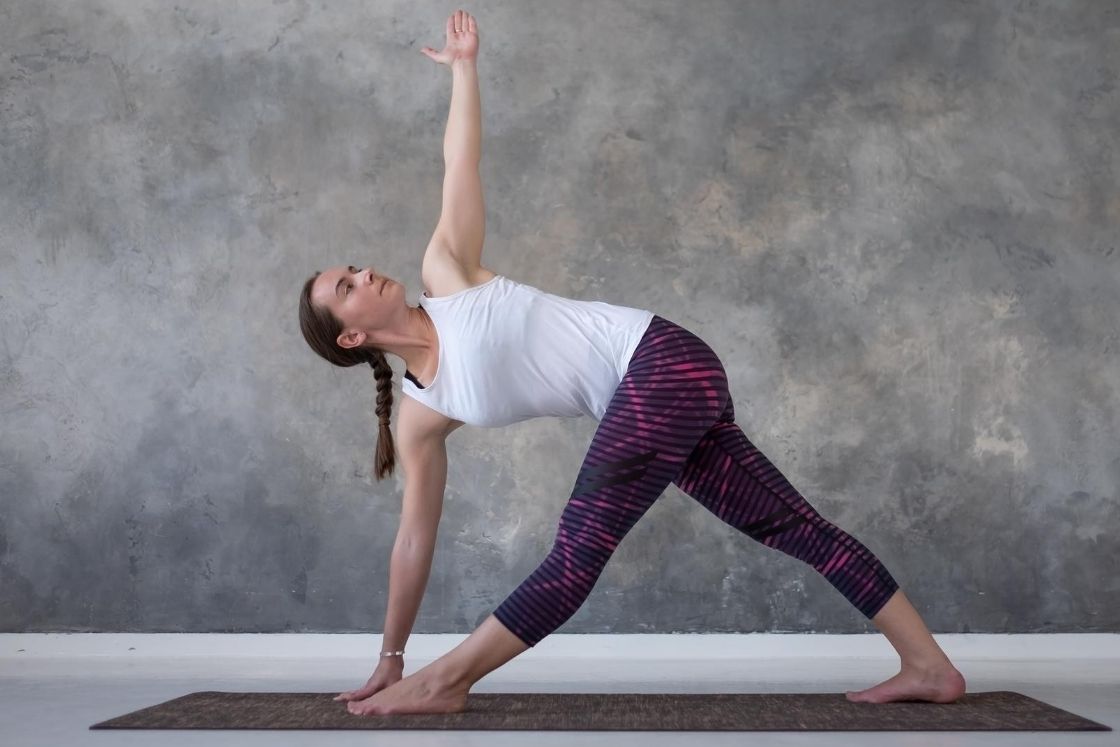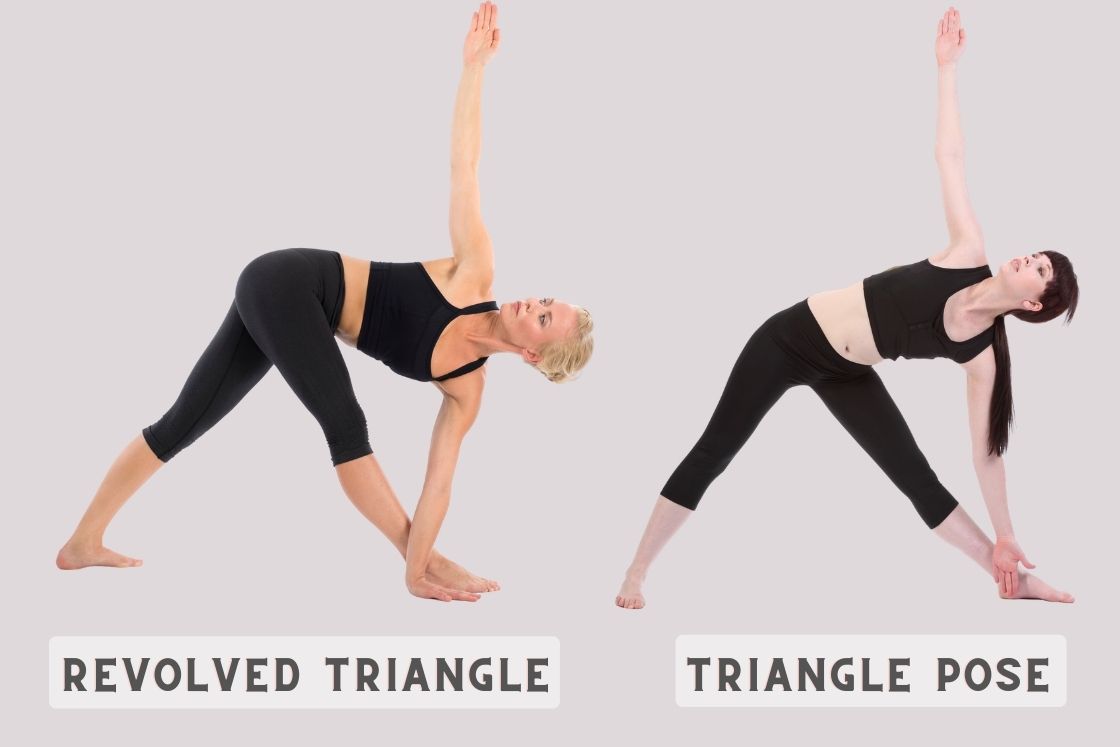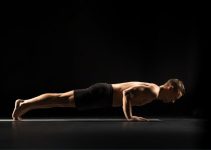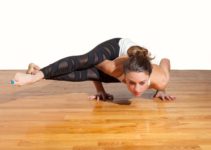
Parivrtta Trikonasana is a counter pose of the Utthita Trikonasana in a way to stretch the opposite sides of the triangle pose body.
This asana is an excellent twisting pose of Hatha Yoga which not only twist your torso but turns out the chattering of the mind.
On doing parivrtta trikonasana for the first time, you might feel a restriction in twisting your torso through hips but it will surely strengthen your hamstring, calve, and abdominal muscles. So it’s usually practiced after mastering the base triangle pose and mountain pose.
Meaning
Parivrtta means revolved and trikonasana is called to triangle pose. In contrast to the simple triangle pose, Parivrtta Trikonasana demands twisting motion in the torso that gives a deeper stretch to the spine.
In this asana, the front torso of a practitioner is ‘revolved’ to the backside while stretching the body in a forward side bend position. This pose makes a triangle with the position of hands and revolved torse so it’s called revolved triangle pose.

You will see a clear difference between the triangle pose and the revolved triangle pose. In the revolved triangle, the torso is rotated about the front stretched leg which makes pelvis hidden behind the leg. While in triangle pose, torso simply bent sidewards without any rotation so pelvis remain in the front side.
The twisting in this asana breaks the block of energy trapped in the form of stiffened muscles. This improves the flow of energy by encouraging flexibility throughout the body.
Parivrtta Trikonasana Practice Guide
Before performing revolved triangle pose, go through the points below:
Precautions & Contraindications
- Practitioners with the condition of spinal and back injury should avoid doing revolved triangle pose.
- It should not be practiced in the condition of migraine, vertigo, and headache; because this could worsen the situation.
- Pregnant women should refrain; as forward bending along with deep twisting could be injurious.
- Also, avoid doing Parivrrta Trikonasana in insomnia, diarrhea, and in the case of high blood pressure, do not lift your arm up.
Preparatory Pose
- Tadasana (mountain pose)
- Utthita Trikonasana (extended triangle pose)
- Reclining Bound Angle Pose (Supta Baddha Konasana)
- Standing Forward Bend (Uttanasana)
- Prasarita padottanasana (Wide-Legged Standing Forward Bend)
How to Do Parivrrta Trikonasana
- Stand in front of your mat in tadasana. Spread your legs 3 to 4 feet apart (slightly more than the shoulder distance). Check your feet if it’s in a straight line or not.
- With an inhalation, lift your arms at the shoulder level and spread them either side of the shoulder, parallel to the floor.
- Now point your right foot slightly in (around 45 degrees) towards your left foot. Turn your left foot towards the extended left hand. Also, turn your torso towards the left foot and try to square your hips.
- With an exhalation, bend forward towards the extended left leg while reaching down with your right hand down to the left leg (keep the palm on the floor just in front of the left foot) and left hand stretched up towards the ceiling. This movement will bring a twist in your torso. Feel the right hamstring pull in this twist.
- Balance your torso along the imaginary line joining heels of feet. Turn your neck and look in the direction of the raised left arm (gaze at left fingertips). Adjust the alignment of the upper body by pushing through the raised arm.
- This is the final position of the revolved triangle pose. Hold on this position for 20 to 30 seconds. Inhale and exhale deeply feeling the complete stretching of the body.
Release
Once done, to come out of the revolved triangle, straight your revolved torso by lowering the raised arm & raising the lower arm to the shoulder level. Then straighten your bent torso and come in a central position as in step 2.
Then repeat this same posture in the opposite direction (here it is the right side).
Beginner’s Tips
- To master revolved triangle pose, remember to keep a check on the alignment of your shoulders while bending and stretching arms up to the down.
- This asana needs intense bending and stretching of the entire body so it is suggested that you prepare your body by doing Utthita Ashwa Sanchalansana (lunge pose) and Vidharbhasana (Warrior pose) to prepare the lower and upper body for intense stretching.
- While bending do not move your head beyond the leg which you are touching with your hands as it will make you lose balance.
In case of assisting one to balance in revolved triangle pose, use the props to modify the base pose by following way:
Props & Modifications
- Use a flip chair as a prop to stretch your calves fully. The legs of the chair which will be in front of your legs will help as a prop to hold on to while you turn towards the opposite direction.
- In case you are unable to touch the ground with your one hand towards the opposite direction, place a block of desired height next front leg and rest your palms over it.
- If you do not have to bend fully You can hold on the seat of the chair and use it as a prop to bend forward.
- You can take the wall support and do Parivrtta Trikonasana as this asana needs more balancing practice for those who are at the beginner’s level.
Follow Up Poses
- Janu Sirsasana or Head-to-Knee Forward Bend
- Parivrtta Ardha Chandrasana (Revolved Half Moon Pose)
- Ardha Matsyendrasana (Half Lord of the Fishes Pose)
Parivrtta Trikonasana Benefits
- Due to the twist in the abdominal area, Parivrtta Trikonasana strengthens the abdominal muscles and builds core muscles.
- This asana strengthens your legs, hips, hamstring, and spine by stretching them.
- It is good for the overall health of the reproductive system of women as it works on the lower back, stretching the hip joints, and pelvis.
- If you have back pain due to lack of sedentary lifestyle this asana will improve your back pain.
- Revolved triangle pose helps in improving the digestion by stimulating the digestive juices in the stomach. Daily practice may help in giving relief from constipation.
- Those who are suffering from obesity will benefit from shedding weight from regularly doing this full-body stretching asana.
- Revolved triangle pose makes the lungs stronger by opening up the chest through twisting movement. Those who suffer from asthma will benefit from this asana.
- Practicing this pose strengthens the neck, quadriceps, and shoulder muscles.
- Revolved triangle pose is one of the best Chakra openings poses. It opens up
- The Third Eye Chakra – As one needs to hold on to the position with complete concentration and alignment of the body,
- Throat Chakra – Due to the twist of the neck relieving all the tension from this area,
- Heart Chakra – As it fully stretches the arms and opens the chest
- Solar Plexus chakra – As it comes with a twist and a bend in the stomach and naval area
- Sacral Chakra – By opening the hip area and stretching the complete spine and tail bone
- Root Chakra – Which form at the base of the triangle pose giving a deep sense of stability and balance.
- This asana is of great help for releasing emotions and healing the blockage of energy. By twisting the torso in this pose, it creates a free flow of energy throughout the body.





Pl guide whether Glaucoma patient practice Parivratta Trikonasana?